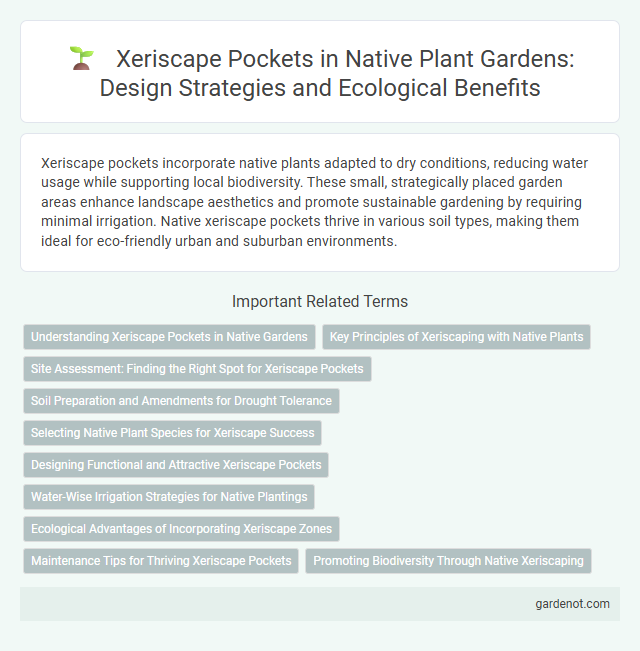Xeriscape pockets incorporate native plants adapted to dry conditions, reducing water usage while supporting local biodiversity. These small, strategically placed garden areas enhance landscape aesthetics and promote sustainable gardening by requiring minimal irrigation. Native xeriscape pockets thrive in various soil types, making them ideal for eco-friendly urban and suburban environments.
Understanding Xeriscape Pockets in Native Gardens
Xeriscape pockets in native gardens utilize drought-tolerant plants to minimize water use while maintaining ecosystem balance. These compact areas incorporate native species that thrive in low-moisture environments, enhancing soil health and biodiversity. Designing xeriscape pockets requires knowledge of local climate, soil conditions, and native flora to create sustainable, low-maintenance garden zones.
Key Principles of Xeriscaping with Native Plants
Xeriscape pockets showcase efficient water conservation by utilizing drought-tolerant native plants adapted to local climates, reducing irrigation needs significantly. Key principles include soil improvement for enhanced moisture retention, strategic plant selection and placement based on sunlight and water requirements, and mulching to minimize evaporation. This eco-friendly landscaping approach promotes biodiversity, decreases maintenance, and conserves water resources effectively.
Site Assessment: Finding the Right Spot for Xeriscape Pockets
Site assessment for xeriscape pockets involves analyzing soil type, sunlight exposure, and drainage to ensure optimal plant growth and water conservation. Identifying areas with poor irrigation or natural drought resilience helps in selecting native drought-tolerant species that thrive with minimal supplemental watering. Understanding microclimates and site-specific conditions promotes sustainable landscaping, reducing water usage and maintenance efforts.
Soil Preparation and Amendments for Drought Tolerance
Soil preparation for a xeriscape pocket involves deep tilling and loosening to promote aeration and water infiltration, essential for drought tolerance. Incorporating organic matter such as compost or aged mulch enhances soil structure and moisture retention, while adding sand or grit improves drainage in heavier soils. Balancing pH levels and applying slow-release fertilizers tailored for native plants ensure optimal nutrient availability under dry conditions.
Selecting Native Plant Species for Xeriscape Success
Selecting native plant species for xeriscape success enhances water efficiency and supports local ecosystems by using drought-tolerant plants adapted to regional climate conditions. Key native species for xeriscape include blue grama grass, desert marigold, and yucca, which require minimal irrigation and thrive in poor soils. Incorporating diverse native plants increases biodiversity, reduces maintenance, and creates resilient landscapes suited to arid environments.
Designing Functional and Attractive Xeriscape Pockets
Xeriscape pockets optimize water conservation by strategically incorporating drought-tolerant native plants that thrive in limited soil spaces. Designing these pockets requires selecting species with complementary root structures and growth habits to enhance soil stability and biodiversity while minimizing irrigation needs. Thoughtful placement of ornamental grasses, succulents, and wildflowers creates visually appealing, low-maintenance areas that support pollinators and reduce urban heat effects.
Water-Wise Irrigation Strategies for Native Plantings
Xeriscape pockets optimize water conservation by incorporating native plants adapted to local climates, minimizing irrigation needs. Water-wise irrigation strategies for native plantings include using drip irrigation systems and scheduling watering during early mornings or late evenings to reduce evaporation. These methods enhance soil moisture retention and promote sustainable landscaping in drought-prone areas.
Ecological Advantages of Incorporating Xeriscape Zones
Xeriscape pockets significantly reduce water consumption by utilizing drought-tolerant native plants adapted to local climate conditions, promoting sustainable landscaping practices. These zones support biodiversity by providing habitat for pollinators, birds, and beneficial insects, enhancing urban ecosystems. Soil health and erosion control improve as xeriscape plants develop deep root systems that stabilize soil and increase organic matter.
Maintenance Tips for Thriving Xeriscape Pockets
Xeriscape pockets require minimal watering, relying on drought-tolerant native plants that thrive in low-moisture conditions. Regularly removing invasive weeds and applying organic mulch helps retain soil moisture and improve plant health. Periodic pruning promotes air circulation, encouraging robust growth and reducing pest problems in xeriscape landscapes.
Promoting Biodiversity Through Native Xeriscaping
Xeriscape pockets using native plants enhance biodiversity by providing essential habitats and food sources for local wildlife, including pollinators such as bees, butterflies, and native birds. Incorporating drought-tolerant indigenous species reduces water consumption while supporting ecological balance and soil health in arid environments. Strategic native xeriscaping fosters resilient ecosystems, contributing to urban green spaces that sustain diverse plant and animal populations.
Xeriscape pocket Infographic

 gardenot.com
gardenot.com